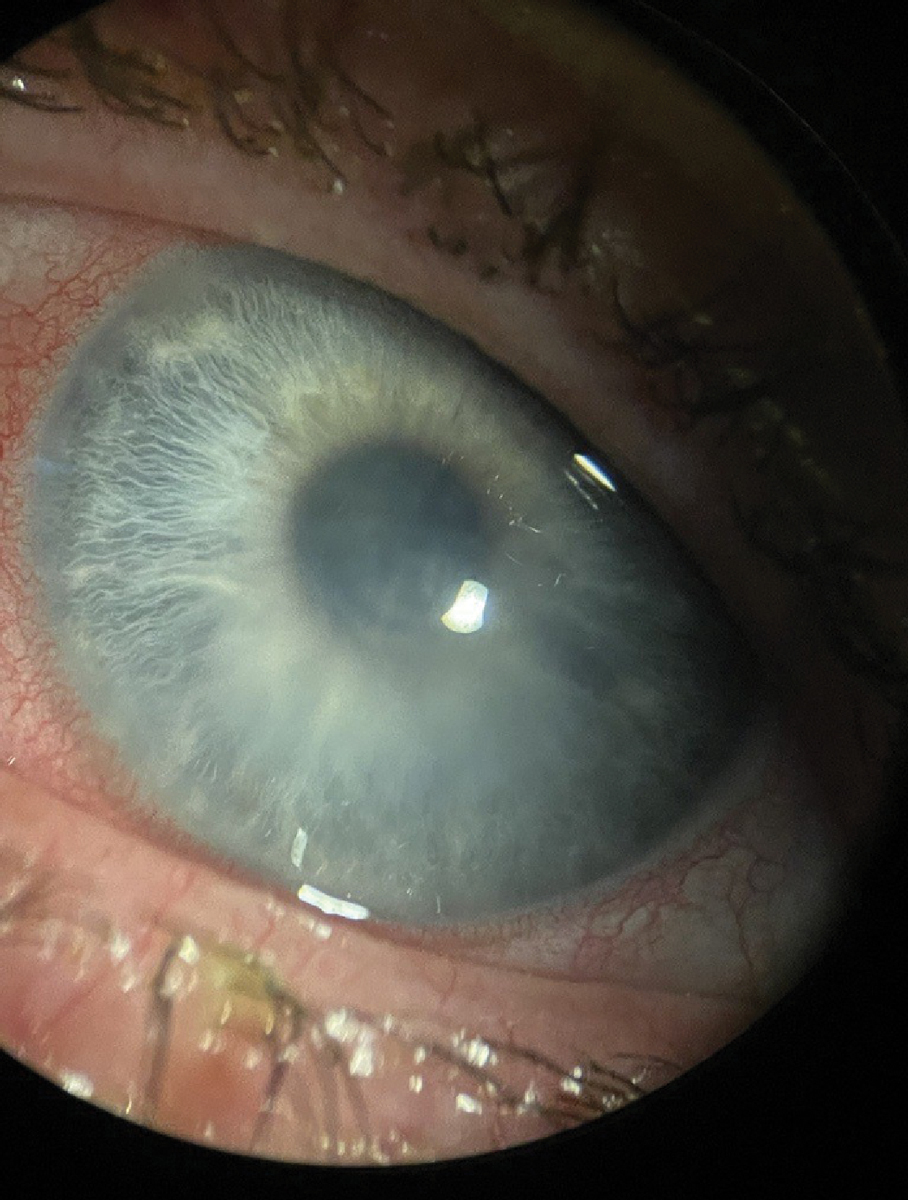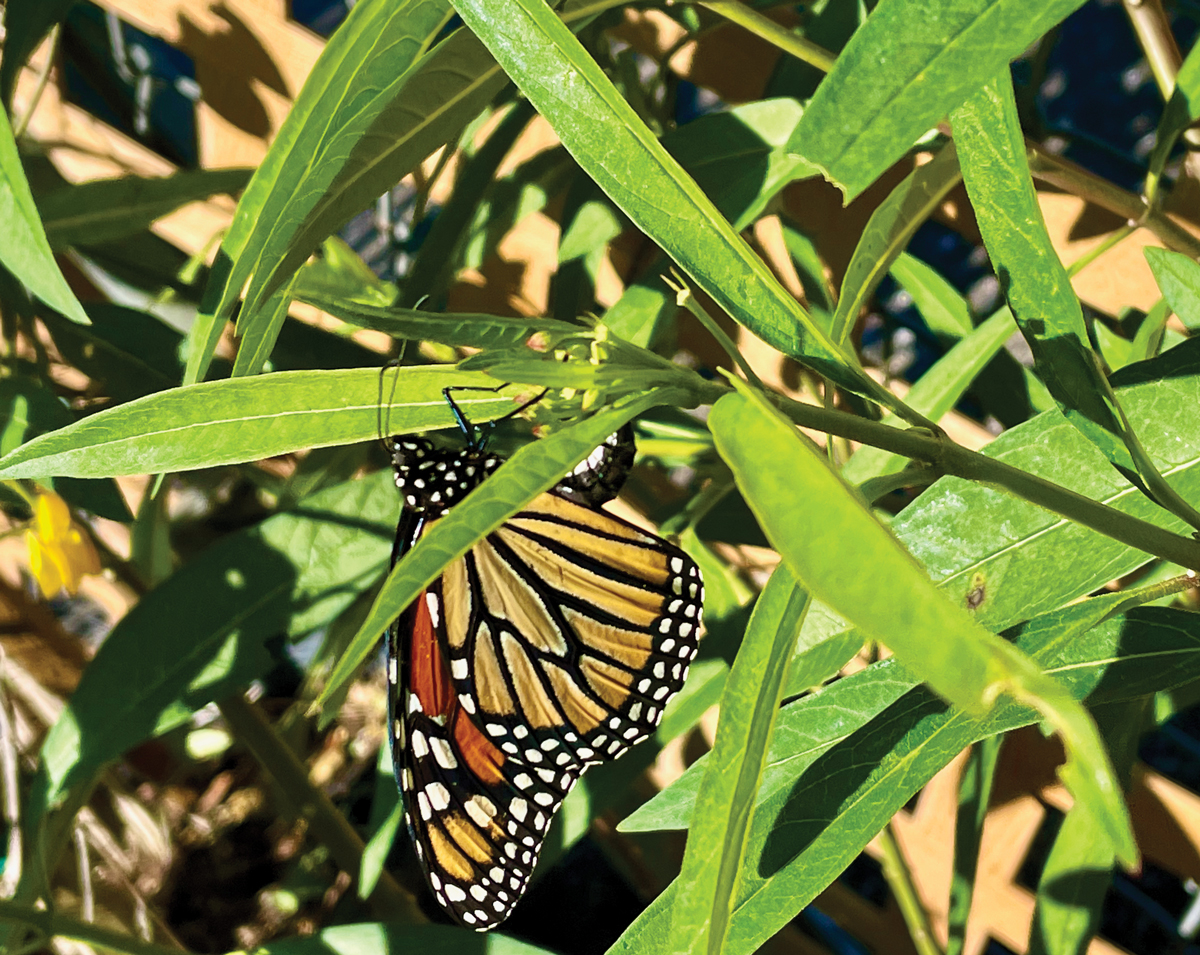 |
Three recent patients presented urgently in distress about their sudden loss of vision. The first was a 24-year-old woman who presented with an acute loss of vision in her right eye of three days’ duration. She described it as hazy and had only mild discomfort. Her visual acuity was 20/100 in that eye. The second patient was a 63-year-old woman who similarly had an acute reduction of vision in her left eye for one day. She had mild discomfort and her acuity in the involved eye was 20/200. The third patient was a 50-year-old man who presented with bilateral blurred vision for one day, measuring at 20/200 OD and OS with moderate discomfort.
The three cases all shared a distinct clinical appearance. There was moderate conjunctival redness without discharge, and the patients’ corneal epithelium were all intact without staining. However, there was significant corneal stromal edema and profound folds in Descemet’s membrane. In all cases, assessment of the anterior chambers was difficult due to the lack of corneal clarity, but there only seemed to be rare few cells, if that. Intraocular pressure was normal in all eyes.
While the stromal and endothelial edema in the face of an intact epithelium may seem confusing and possibly point to a manifestation of herpetic disease, the appearance was classic for a certain phenomenon. When pointedly asked, the women acknowledged being amateur lepidopterists who cultivated gardens to attract butterflies, and the man was a landscaper who had been removing weeds when the incident happened. Thus, they all confirmed that they had been exposed to milkweed (Asclepias) and were manifesting milkweed toxicity.
 |
| Stromal edema and folds in Descemet’s membrane from milkweed toxicity. Click image to enlarge. |
Background
Popular with residential and urban gardeners, milkweed is a hardy, native perennial most appreciated for its color and fragrance, as well as a habitat for one of the most easily recognized and appreciated butterflies, the monarch (Danaus plexippus). Central to the conservation strategy of restoring the monarch butterfly population in the United States is the residential planting of milkweed, the monarch’s obligatory host plant.1 While the milkweed’s nectar supports the many pollinators, insects and fauna that rely on it, monarch butterflies lay eggs on the underside of its leaves, where newly hatched caterpillars feed exclusively on the leaves of the milkweed plant.1
Milkweed is named for a milky substance within the plant tissue called latex, which contains a high concentration of naturally occurring cardiac glycosides termed cardenolides, which are exuded when the plants are damaged.2 Cardenolides, present in milkweed leaves, stems, roots and latex are natural toxins that protect the plant, as well as the insects that ingest them, from predation.2,3
In humans and large animals, cardenolides can be toxic when ingested, due to inhibition of sodium-potassium pump activity in endothelial cells.2,4 Therapeutically, cardenolides found in milkweed and other plant species have long been used for their cardiotonic, or stimulant, activity, with the most well-known being digoxin, used in the treatment of congestive heart failure and atrial fibrillation, which was initially isolated from the foxglove plant (Digitalis lanata).4
Indirect ocular exposure to cardenolides resulting in stromal edema is the most common symptom that can occur through contact with milkweed latex, stems, leaves or roots through eye rubbing following handling, although direct exposure with milkweed latex has also been described.5-10 Cardenolide levels differ by species, and the concentration of cardenolides varies throughout milkweed tissue, with up to 100-fold higher concentration in latex vs. leaf tissue.2
When in contact with the ocular surface, cardenolides are able to penetrate an intact cornea and act to inhibit endothelial sodium-potassium pumps, resulting in corneal stromal edema and a reduction in visual acuity.5-10
 |
|
Milkweed is considered the monarch butterfly’s obligatory host plant. Click image to enlarge. |
Treatment
While eye washing is indicated following direct exposure to milkweed latex, indirect ocular exposure after handling and eye rubbing may not be realized until visual symptoms develop, which may be hours after exposure. Treatment of corneal toxicity due to milkweed exposure centers on topical ophthalmic corticosteroids.5-10
While dexamethasone and triamcinolone have been described to increase sodium-potassium pump density and prevent inflammation-mediated reduction in sodium-potassium pump activity of corneal endothelial cells, the resolution of corneal edema due to milkweed toxicity has been described using a variety of strong topical ophthalmic steroids.5-11 The time to resolution of corneal edema and complete visual recovery after beginning treatment is generally rapid and occurs within two weeks, with a single reported case requiring 270 days.5-10
Once milkweed toxicity was confirmed by the distinct clinical appearance and compelling history, treatment was straightforward. Because the epithelium was intact in all three patients, there was no need for a topical antibiotic. The most effective treatment is a topical steroid of moderate to strong potency (e.g., prednisolone, difluprednate, loteprednol) dosed four to six times per day. Mild cycloplegia can also be used.
Each of the three patients was prescribed prednisolone acetate 1% four times daily, with the reminder to shake the medication bottle well prior to instillation. All showed marked improvement in vision within two days and all completely resolved within 10 days. All patients were relieved and grateful that the diagnosis was easily found through proper recognition.
Corneal endothelial toxicity due to milkweed contact and exposure continues to be more and more common and often overlooked as a diagnosis. These three recent patients illustrated the need to recognize a classic clinical appearance and follow-up with a very directed history.
Every rose has its thorn, and while all milkweed species carry the risk of corneal toxicity, there’s certainly no need to pull them from the garden. Basic gardening safety including eye protection, wearing gloves, immediately washing hands after handling plant material and avoiding eye rubbing go a long way for preventing milkweed corneal toxicity.
Dr. Steen is an assistant professor at Nova Southeastern University College of Optometry where she serves as director of the Glaucoma Service, coordinator of the Primary Care with Emphasis in Ocular Disease Residency and teaches courses in glaucoma and ocular pharmacology. Her financial disclosures include Bausch & Lomb, Santen, Ocuphire and Carl Zeiss Meditec.
Dr. Sowka is an attending optometric physician at Center for Sight in Sarasota, FL, where he focuses on glaucoma management and neuro-ophthalmic disease. He is a consultant and advisory board member for Carl Zeiss Meditec and Bausch Health.
1. Baker AM, Redmond CT, Malcolm SB, et al. Suitability of native milkweed (Asclepias) species versus cultivars for supporting monarch butterflies and bees in urban gardens. PeerJ. 2020;8:e9823. 2. Züst T, Petschenka G, Hastings AP, et al. Toxicity of milkweed leaves and latex: chromatographic quantification vs. biological activity of cardenolides in 16 Asclepias species. J Chem Ecol. 2019;45:50-60. 3. Duffey SS, Scudder GGE. Cardiac glycosides in North American Asclepiadaceae, a basis for unpalatability in brightly colored hemiptera and coleoptera. J Insect Physiol. 1972;18(1):63-78. 4. Abbott AJ, Holoubek CG, Martin RA. Inhibition of Na+,K+-ATPase by the cardenolide 6’-O-(E-4-hydroxycinnamoyl) desglucouzarin. Biochem Biophys Res Commun. 1998;251:256-9. 5. Lee YJ, Han SB, Hyon JY. Corneal endothelial dysfunction caused by Asclepias curassavica in a young farmer. Am J Ophthalmol Case Rep. 2019;16:100564. 6. Yang JF, Beal CJ. Corneal toxicity secondary to latex from Asclepias curassavica in a pediatric patient. Cornea. 2021;40:1607-9. 7. Venkateswaran N, Tonk RS, Berrocal A. Corneal edema in a gardener. JAMA Ophthalmol. 2020;138(9):998-9. 8. Mikkelsen LH, Hamoudi H, Gül CA, Heegaard S. Corneal toxicity following exposure to Asclepias tuberosa. Open Ophthalmol J. 2017;11:1-4. 9. Matsuura K, Hatta S, Terasaka Y, Inoue Y. Extensive bilateral corneal edema six weeks after cataract surgery: keratopathy due to Asclepias physocarpa: a case report. BMC Ophthalmol. 2017;17(1):5. 10. Amiran MD, Lang Y, Yeung SN. Corneal endothelial toxicity secondary to Asclepias fruticosa. Eye (Lond). 2011;25(7):961-3. 11. Macdonald JM, Geroski DH, Edelhauser HF. Effect of inflammation on the corneal endothelial pump and barrier. Curr Eye Res. 1987;6(9):1125-32. |

